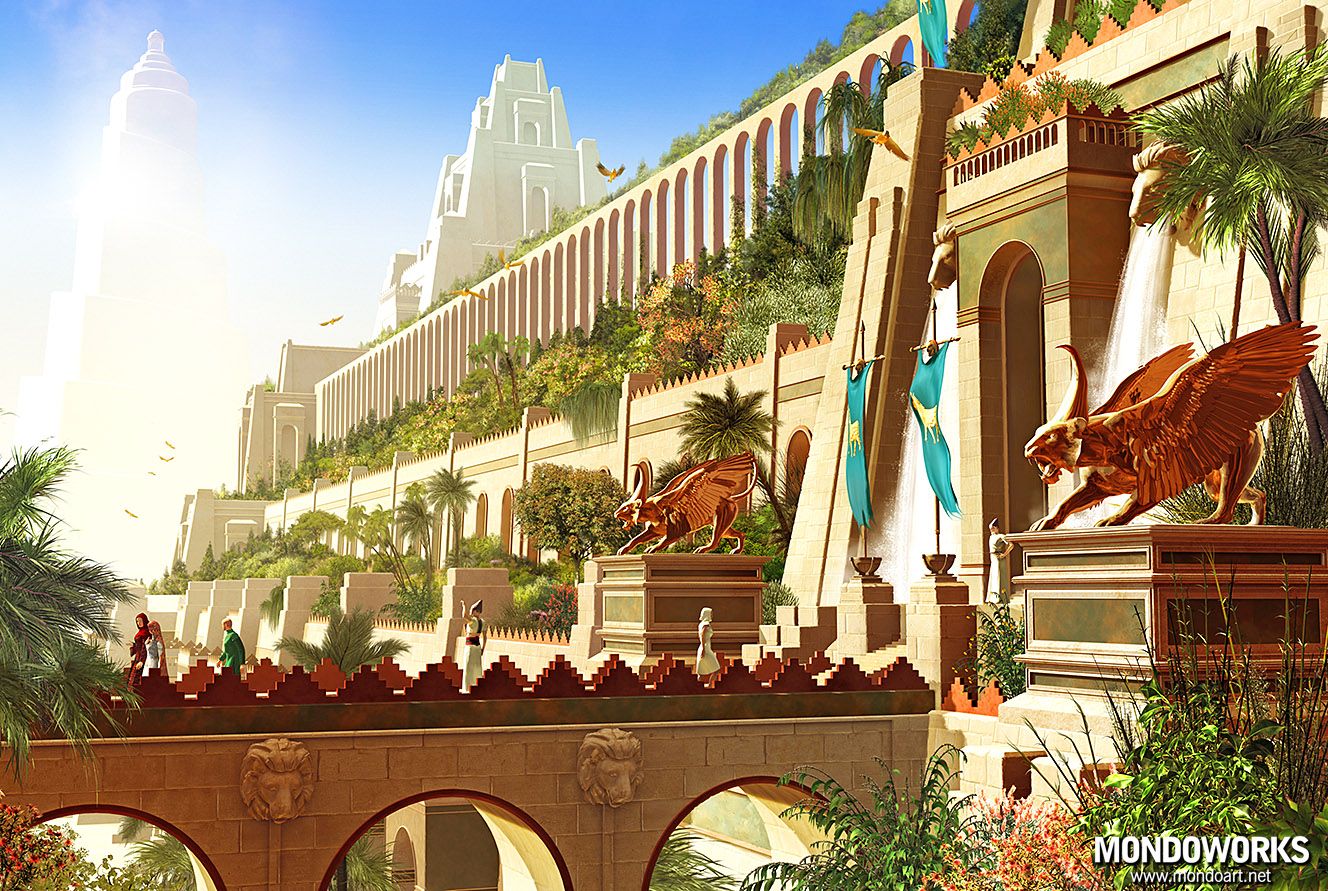Seven Wonders of the World Part 5 - The Hanging Gardens of Babylon
An illustration by Mondolithic Studios/MondoWorks/Mondoart.net
The Hanging Gardens of Babylon were one of the Seven Wonders of the Ancient World, a term given to it by ancient Hellenic culture. The Hanging Gardens were described as a remarkable feat of engineering with an ascending series of tiered gardens containing a wide variety of trees, shrubs, and vines. The gardens were said to have looked like a large green mountain constructed of mud bricks.
The Hanging Gardens is the only one of the seven ancient wonders for which the location has not been definitively established. Traditionally they were said to have been built in the ancient city of Babylon, near present-day Hillah, Babil province, in Iraq. The Babylonian priest Berossus, writing in about 290 BC and quoted later by Josephus, attributed the gardens to Neo-Babylonian King Nebuchadnezzar II, who ruled between 605 and 562 BC. There are no extant Babylonian texts which mention the gardens, and no definitive archaeological evidence has been found in Babylon. Because no physical evidence for the Hanging Gardens has been found at Babylon, two theories have been suggested. One is that they were purely mythical, and the descriptions found in ancient Greek and Roman writers including Strabo, Diodorus Siculus and Quintus Curtius Rufus represent a romantic ideal of an eastern garden. If it did indeed exist, it was destroyed sometime after the first century AD. The other theory is that they were actually in the city of Nineveh, constructed by the Assyrian king Sennacherib. According to one legend, Nebuchadnezzar II built the Hanging Gardens for his Median wife, Queen Amytis, because she missed the green hills and valleys of her homeland. He also built a grand palace that came to be known as “The Marvel of the Mankind”. Stephanie Dalley suggests that the original garden may have been a well-documented one that Assyrian King Sennacherib (704–681 BC) built in his capital city of Nineveh on the River Tigris, near the modern city of Mosul.
There are five principal writers whose descriptions of Babylon are extant in some form today. These writers concern themselves with the size of the Hanging Gardens, their overall design and means of irrigation, and why they were built. Josephus (c.37–100 AD) quotes a description of the gardens by Berossus, a Babylonian priest of Marduk writing circa 290 BC. Berossus described the reign of Nebuchadnezzar II and is the only source to credit that king with the construction of the Hanging Gardens. In this palace he erected very high walks, supported by stone pillars; and by planting what was called a pensile paradise, and replenishing it with all sorts of trees, he rendered the prospect an exact resemblance of a mountainous country. This he did to gratify his queen, because she had been brought up in Media, and was fond of a mountainous situation.
Hanging gardens of Semiramis, by H. Waldeck
Diodorus Siculus (active c.60–30 BC) seems to have consulted the 4th century BC texts of both Cleitarchus (a historian of Alexander the Great) and Ctesias of Cnidus. Diodorus ascribes the construction to a Syrian king. He states that the garden was in the shape of a square, with each side approximately four plethra long. The garden was tiered, with the uppermost gallery being 50 cubits high. The walls, 22 feet thick, were made of brick. The bases of the tiered sections were sufficiently deep to provide root growth for the largest trees, and the gardens were irrigated from the nearby Euphrates.
Quintus Curtius Rufus (fl. 1st century AD) probably drew on the same sources as Diodorus. He states that the gardens were located on top of a citadel, which was 20 stadia in circumference. He attributes the building of the gardens to a Syrian king, again for the reason that his queen missed her homeland.
The account of Strabo (c.64 BC – 21 AD) possibly based his account on the lost account of Onesicritus from the 4th century BC He mentions that the gardens were watered by means of a screw leading to the gardens from the Euphrates.
Philo of Byzantium (4th–5th century AD) is the last of the classical sources. The description of the gardens in his A Handbook to the Seven Wonders of the World is thought to be independent of earlier Greek sources. The method of raising water by screw matches that described by Strabo. He marvels at the engineering and ingenuity of building vast areas of deep soil, which had a tremendous mass, so far above the natural grade of the surrounding land. The irrigation techniques were also a marvel. *Wiki
Contact [email protected] for commissions and syndications.